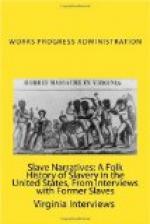Everything went along beautifully until time came to House the tobacco and not a negro cropper would use this barn for his tobacco. So I had my individual crop housed in this barn. As the type of tobacco mostly grown at that time was bark fired someone had to stay at the barn night and day to attend the fires and watch that a stick of tobacco did not drop in the blaze and burn the barn and contents. As long as my husband or myself stayed in or around the barn we did not have trouble with these darkies but sometimes it to attend to other matters on this farm and had to leave a hired negro in charge and as soon as we would get out of sight of the barn the negro would desert his post. It became evident that one or the other of us stay at this barn night and day until firing season was over. The same thing happened when the stripping season began. These conditions continued until a wind storm blew this barn down. Still I hoard some of the negroes express their thoughts.
Mr. G—— sho had no tention of dat barn standing. I had the tenants separate this lumber for different uses on the farm and the scrap lumber was to be taken to the cabin or the main dwelling to be used as kindling and not a negroe would use this kindling. One negro a tall black man around seventy years old said, “No dat wood wont burn”. I asked, “Why”? He said, “Mr. G—— would sho hant me if I teched a single piece of dat wood ter burn.” So naturally the main dwelling had a bountiful supply of kindling.
This farm was watered by a big spring and branch that ran along behind the stables and near this particular barn and this branch run into a big sink hole and then through a small crevice underground. Once cold and disagreeable winter something blocked this crevice and the waters soon overflowed the sink hole and extended all over the lowlands near. The winter was severely cold and this water began to moderate and a light drizzle of rain was falling and most of the tenants on the farm had retired for the night when suddenly this ice on the stream broke up and in some manner the crevice had been opened and the sound from this water going in its course underground was terrific. My family as well as myself were very much frightened. No one can imagine the commotion that existed at the cabins on the tenant row near the stream. Negroes poured from the cabins in all manners of dress or undress even the cold weather did not tempt them to take time to don shoes and hose but came to the back door of my house some crying and moaning and praying, and if there is such a thing as a pale negro these darkies were certainly pale, eyes rolling and the majority of them wanting to leave the farm before daybreak or by that time anyway or else staying in our home all night. Fires were made in the kitchen and they congregated there and most of them remained there all night. One old negro said or acted as spokesman for the crowd. “Dat all this crowd of niggers need dat Mr. G—— was afer dem and meant foh dem to move or git.”




